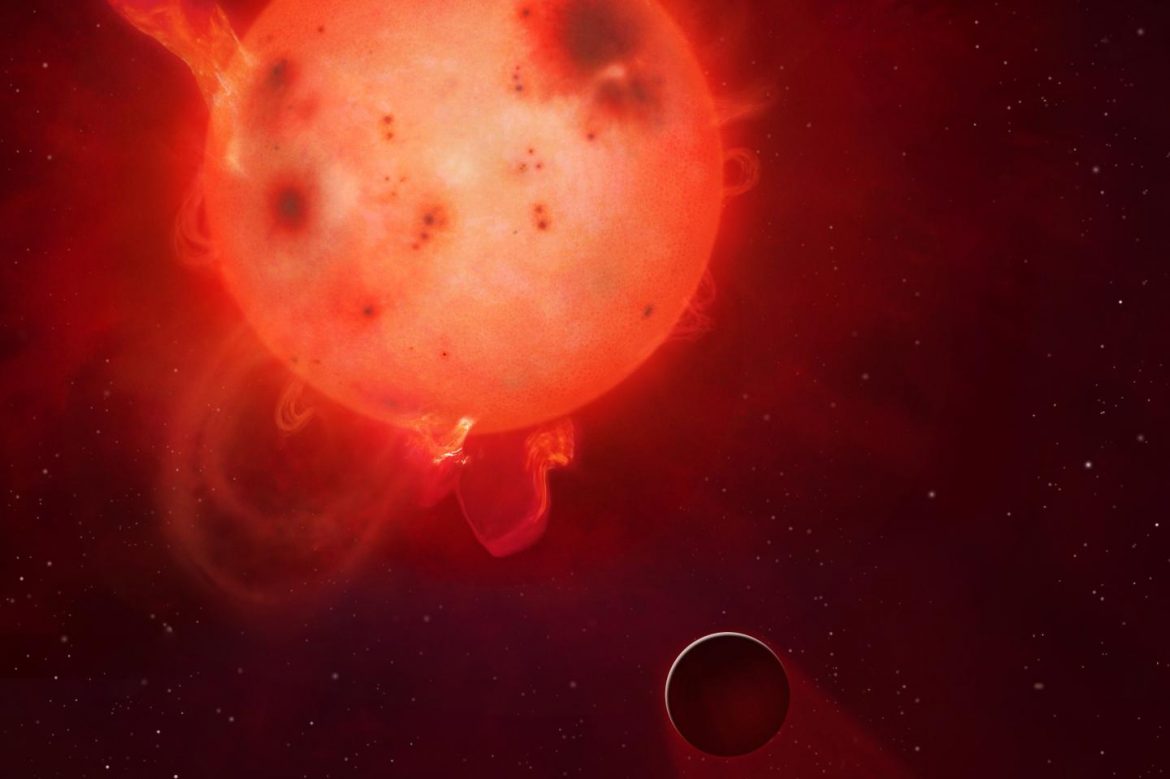Right planet, wrong star…
A new study by a team of astronomers has shown that an extrasolar planet most resembling the Earth was literally ill-starred. It could have lost any chance of hosting life because of the powerful flares of its turbulent star.
The planet, named Kepler-438b, is located 470 light years from the Earth in the constellation Lyra. Orbiting a star much smaller and dimmer than the Sun, the planet lies within a belt around the host star called the “habitable zone”, where temperatures allow the existence of liquid water essential for life as we know it.
The planet tops the list in the Earth Similarity Index with a rating of 0.88. With a diameter 1.12 times that of the Earth, Kepler -438b is believed to be a rocky planet. Its surface temperature was calculated to be 0-60°C, in sharp contrast with the scorching or frigid temperatures of the most of the 2000-odd exoplanets confirmed until now. In terms of habitability, things go well so far. But there’s a problem: Although the planet looks like our world, its star is much different from ours.
Kepler-438 is a “red dwarf” star of spectral class M which makes up three-quarters of all the stars in the Milky Way. (See: Kurious, “How do the stars line up?” https://kurious.ku.edu.tr/sites/kurious.ku.edu.tr/files/startypes_-_astronomy-_pdf.pdf)
These stars have masses from 8 t0 60 percent that of the Sun. Kepler-438b is one of the biggest of the red dwarfs, packing 0.540 solar mass. It’s surface temperature of 3750°C is much lower than the Sun’s 5500°C. So, as is the case for other M-class stars, its habitable zone is very close to the star. In fact, Kepler-438b’s orbit is only 25 million km from the star, which is half the distance of Mercury’s orbit from the Sun. And that being so, the year of Kepler-438b, that is, its orbital period is just 25 days.
The proximity of the habitable zones to red dwarf stars constitute a serious risk for the planets lying within. Because, these stars typically zap their surroundings with intense radiation and charged particles spewed by violent magnetic storms on their surfaces.
These storms, called “flares”, on Kepler-438 were seen to be 10 times more powerful than those on the Sun and repeating every 200-300 days. These “superflares” are estimated to have energies equal to one an explosion of 100 billion megatons of TNT could produce (1 megaton = 1 million tons).
According to the Warwick University (UK) researchers who led the study, like those occurring on the Sun, these extremely powerful magnetic storms could be hurling huge blobs of ionized (electrically charged) particles into space from the hot outer atmosphere of the star called the “corona”.
If Kepler-438b has a strong magnetic shield as the Earth has, it may be assumed that it is protected from these plasma pulses to some extent. If not, however, it is highly probable that energetic protons and electrons travelling with great speeds in the plasma clouds of billions of tons flung into space in these events called “coronal mass ejections” would sweep the planet’s atmosphere into outer space and make the emergence of life impossible. In case it is stripped of its atmosphere, it will be even harder for Kepler-438b to support life since it will also be exposed to intense ultraviolet and X-ray radiation from the superflares.
REFERENCES
- 1. “Radiation blasts leave most Earth-like planet uninhabitable, new research suggests”, University of Warwick, 17 November 2015
- 2. https://en.wikipedia.org/wiki/Kepler-438b


